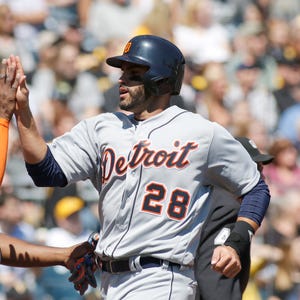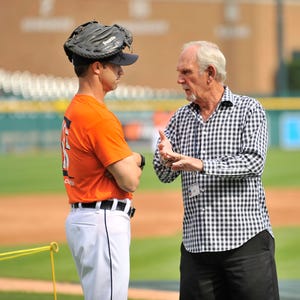Green: Jackie Robinson’s dynamic baseball skills often overlooked – The Detroit News
So often when you reach the late 80s and you are fortunate, there are precious flashbacks to your boyhood. You were young and impressionable then and every sight was brand new. And it was when baseball became the first game that mattered.
There is Lou Gehrig, who played with style and dignity, and the memory of a home run he hit into right field at Yankee Stadium. A line drive, still captured in my memory. There is the young Joe DiMaggio, a rookie then, and later his young brother, Dominic, who played for the Red Sox and was the best fielding center fielder ever.
For some rotten reason, Dominic was ignored by us, the Baseball Hall of Fame voters, despite a career batting average of .298. Dom belongs but he was overshadowed by his brother Joe – and the Red Sox were outshined by the Yankees.
There is Ted Williams, who played with Dom on the Red Sox.
I cannot verify whether Williams was “the best bleeping hitter in the history of baseball,” as was his own claim. But he was the best hitter of my lifetime and is still so brilliantly etched in my memories.
There is the magnificent Stan Musial. And there is Hank Greenberg, who was such a dominant force for the Tigers.
And there are Willie Mays and Roberto Clemente and Henry Aaron – players of my early years as a sports journalist. Clemente, the best player ever by my five-tool gauge. If only he had the good fortunate to have played in New York or Los Angeles, and if only he had not died prematurely on a mercy mission while still amassing his records.
And Mays, so great and so much the spirit of Major League Baseball once upon a time when I was young. And Aaron, who bumped Babe Ruth from the top of baseball’s heralded home-run list and who treated the journalists following him with dignity – while receiving death threats.
All these ballplayers with their skills and the nuances flashed back at me in my fit of nostalgia this past week. I was captivated watching the four hours of the Jackie Robinson documentary, the latest in Ken Burns’ historic films.
There now, again, was Jackie Robinson, the man, the pioneer who liberated our nation as the first black athlete to appear in a modern Major League Baseball lineup. The date April 15, 1947 – a date preserved now when all major league players on all teams wear uniform No. 42, Robinson’s number with the Brooklyn Dodgers.
The date is fixed in my memory as the day Robinson played his first game in the majors. All these years I have felt linked to Robinson – April 15, his momentous debut; April 15, every year, I attach another number to my age. Cannot avoid it, usually tax day – and every year, another – so fortunate – birthday.
And in my musings about the sport then and all of sports now, I thought in some way it’s a shame that Jackie Robinson is remembered – and praised – only as the guy who so courageously broke baseball’s color line.
All these years, I think now, one of Robinson’s finest attributes has been overlooked. His skills, his presence on the ball field as a dominant athlete have been diminished by his role as a trailblazer.
It is a shame now that when baseball delivers its annual tribute to Robinson two generations of today’s sports-loving Americans do not know how great an athlete he was. They know his history and how he impacted the civil rights movement.
But they did not realize how greatly he was skilled as an athlete beyond his history and his battles for justice and equality.
And for me, just turned 19 in 1947 (do the addition, if you care), Jackie Robinson at bat, on the base paths, was the most electrifying ballplayer of my lifetime. There in my personal memories with Gehrig and Williams and DiMaggio and Musial and Greenberg and Clemente and Mays and Aaron.
Wisely, there was ample footage in Burns’ documentary of Robinson the ballplayer. Plenty to bolster the old visions of Robinson, the pure athlete.
Jackie Robinson, to me, played the game in a vibrant staccato. He seemed to play in segments.
At bat, he held his arms stretched from his body and he would bring the bat back, hesitate for a tiny moment, then lash at the ball with a fury. Mostly, when he connected, he would hit line drives.
Then he was off with a running style I would never see in another base runner through all my years at ballparks. He tended to sway to the left and sway to the right, advancing at speed, with his arms thrusting, legs churning.
He was intimidating to the pitchers as a batter and as a base runner. He was intimidating to the infielders who might have to collide with him at the next base.
But all of it – to me – was spurted in Robinson’s stop-restart speedy staccato.
And there it was all refreshed for me by Burns’ film artistry – Burns, who spent much of his own boyhood living in Ann Arbor.
Maudlin memories – so many of them when you journey deep into your 80s and you are fortunate when you reach the Double 8s.
And more of those ancient images: The basic thought that those who love baseball would never have had the pleasures of watching so many brilliant athletes were it not for Jackie Robinson.
The great Roberto Clemente and Willie Mays and Hank Aaron; and Robinson’s teammates in Brooklyn, Roy Campanella and Don Newcombe; later Barry Bonds and Derek Jeter, the classic ballplayer; and David Price; and the Hispanic ballplayers, Miguel Cabrera and David Ortiz. And a multitude more.
Jerry Green is a retired Detroit News sports writer.





